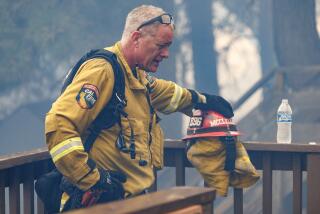Forest Service drops contract for six firefighting planes
The U.S. Forest Service is dropping one of its air tanker contracts, reducing the size of its aerial firefighting fleet with months left in California’s fire season.
Citing safety concerns, the agency announced Friday that it had canceled a contract with Aero Union Corp. of Chico, Calif., for the exclusive use of six P-3 tankers. “We can’t in good conscience maintain an aviation contract where we feel lives may be put at risk due to inadequate safety practices,” Tom Harbour, the Forest Service’s fire and aviation director, said in a news release.
Agency officials said they have a number of other tankers at their disposal along with nearly three dozen water-dropping helicopters. They also expect the fire season, which in California runs until November, to start tapering off in much of the West.
“We just don’t see anything out of normal, in fact we see a little bit below normal” for the rest of the year, said Karyn Wood, Forest Service director of operations at the National Interagency Fire Center in Idaho. “We believe the equipment we have will be capable of handling the fire season.”
But California fire officials said they were worried that the loss of the Aero Union tankers would place more demands on the state’s firefighting aircraft. “We’re very concerned and we’ll be watching” the situation closely, said Janet Upton, a deputy director of the California Department of Forestry and Fire Protection.
In its cancellation announcement, the Forest Service said the company had not lived up to the airworthiness provisions of its five-year contract, which dates from 2008: “Aero Union informed the Forest Service that the Federal Aviation Administration found the company was not in compliance with its mandated structural inspection program requirements.”
Officials at Aero Union could not be reached for comment. The Forest Service contract, which guaranteed Aero Union a minimum of $14.6 million this year, is 66 pages long. Much of the document deals with safety requirements and procedures, including rigorous inspection and safety checks as well as meticulous maintenance of each aircraft’s records.
Dennis Hulbert, who retired last year as the Forest Service’s regional aviation chief in California, called Aero Union’s P-3 tankers the backbone of the aerial firefighting arsenal. “They were generally one of the more effective planes in the fleet,” he said.
The four-engine turboprop aircraft have been retrofitted to carry about 3,000 gallons of retardant and are considered by fire managers as workhorses, capable of flying in conditions and terrain that might exclude other fixed-wing aircraft. But the planes are old, Hulbert said, and coming to the end of their useful life in wildfires.
The Forest Service has contracts with two other companies to use 11 P-2 tankers with a smaller capacity. But they are in no better shape than the P-3s, Hulbert added, and have crashed at least three times since 2003.
“They are older, hold less retardant, and not as effective,” said Hulbert, who is now an aviation consultant. “They are all on their last leg.”
The Forest Service has contracts to use a variety of other aircraft: two DC-10s, the retrofitted passenger jets that can drop large amounts of retardant; as many as 34 helicopters; and C-130s operated by the National Guard. In addition, Wood said the agency was flying two large air tankers in from Alaska to compensate for the loss of the Aero Union planes.
Next month, Wood said, the Forest Service is planning to ask tanker companies for “a strategy to modernize the fleet.”
“We are looking for something else,” she added. “We’re testing the water. … What’s out there? What can people develop?”
More to Read
Sign up for Essential California
The most important California stories and recommendations in your inbox every morning.
You may occasionally receive promotional content from the Los Angeles Times.












